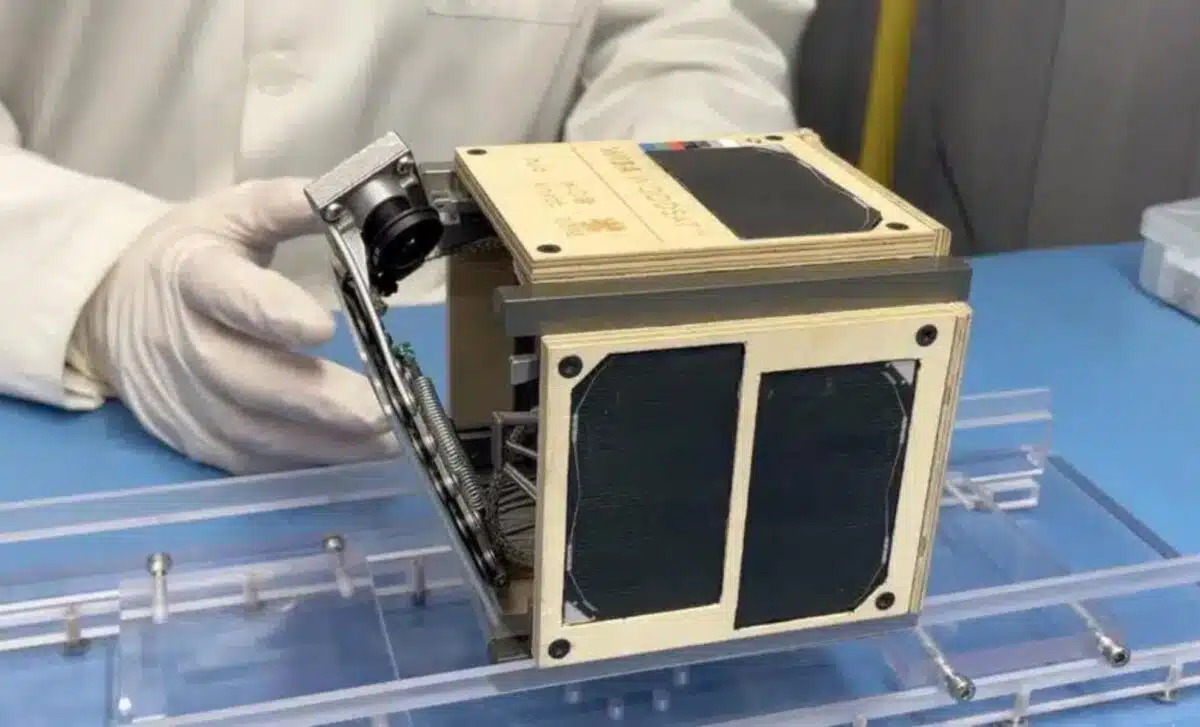
Published on May 29, 2024 08:27 By Lydia Amazouz
Collected at : https://dailygalaxy.com/2024/05/japan-first-wooden-satellite-lignosat/
In a groundbreaking development, Japanese researchers have successfully created the world’s first wooden satellite, aptly named LignoSat. This innovative satellite marks a significant leap in combining traditional materials with modern space technology.
Developed through a collaboration between Kyoto University and Sumitomo Forestry Co., LignoSat represents a four-year endeavor aimed at enhancing the environmental sustainability and cost-efficiency of satellite construction. The satellite aims to revolutionize the space industry by demonstrating the feasibility of using wood, a renewable resource, in satellite technology.
This project reflects Japan’s commitment to innovation and sustainability, pushing the boundaries of what is possible in space exploration.
The Unique Design and Construction
LignoSat is a testament to the ingenuity of Japanese craftsmanship and modern engineering. The satellite is a compact, 10-centimeter cube constructed primarily from magnolia wood panels, each measuring between 4 and 5.5 millimeters in thickness. The frame incorporates aluminum components to enhance structural integrity.
Notably, the construction employs traditional Japanese techniques, avoiding the use of screws or adhesive materials, which further underscores the satellite’s eco-friendly design. This method not only highlights the versatility and strength of wood but also aligns with sustainable practices. Equipped with solar panels on several of its sides, LignoSat weighs approximately 1 kilogram.
The durability of the wooden materials has been rigorously tested and confirmed to withstand the harsh conditions of outer space, making this satellite a pioneering example of sustainable space technology. The design process also included extensive thermal and vacuum testing to ensure the satellite’s performance in extreme conditions.
Environmental Benefits and Technological Innovation
One of the primary motivations behind LignoSat’s development is its environmental advantage over conventional metal satellites. When traditional satellites re-enter the Earth’s atmosphere, they can produce alumina particles, which may negatively impact weather patterns and communication systems. In contrast, wooden satellites like LignoSat burn up more cleanly, reducing the environmental footprint of space missions.
The project underscores the potential of using wood, a renewable and sustainable resource, in space applications. By exploring this unconventional material, the researchers aim to open new avenues for eco-friendly space technology. This initiative is not only a technological innovation but also a step towards reducing space debris and promoting environmental responsibility. The success of LignoSat could inspire future projects to consider sustainable materials, thus fostering a new era of green space exploration.
Launch and Mission Details
LignoSat is scheduled to be launched aboard a SpaceX rocket from the United States in September. Before this, it will be handed over to the Japan Aerospace Exploration Agency (JAXA) on June 4. Once launched, the satellite will be transported to the International Space Station (ISS), where it will be deployed into space about a month later.
The mission will focus on collecting and analyzing data sent back from LignoSat. This data will be crucial in understanding the performance and potential of wood as a material for space technology. The insights gained could pave the way for more sustainable practices in satellite construction and other space-related endeavors. The launch will also serve as a proof of concept, demonstrating the viability of wood in space conditions and potentially influencing future satellite design.
Japan’s Ambitious Plans for Future Space Technology
Looking ahead, the team behind LignoSat has ambitious plans to further innovate and enhance the use of wood in space technology. There are aspirations to develop satellites where even the electronic substrate portions are made entirely of wood. Such advancements could revolutionize the space industry, aligning it more closely with global sustainability goals. The successful development and upcoming launch of LignoSat not only highlight the ingenuity of
Japanese research and technology but also represent a significant step towards more environmentally conscious space exploration. As the world looks to the stars, initiatives like LignoSat remind us of the importance of sustainability and the potential of traditional materials in modern technology.
The ongoing research and future developments in this field may lead to more eco-friendly solutions and inspire other countries to explore similar sustainable technologies. The project sets a precedent for integrating traditional craftsmanship with cutting-edge science, paving the way for a new frontier in space exploration.

Leave a Reply